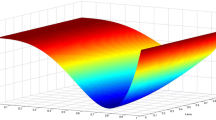Abstract
A moving collocation method is proposed and implemented to solve time fractional differential equations. The method is derived by writing the fractional differential equation into a form of time difference equation. The method is stable and has a third-order convergence in space and first-order convergence in time for either linear or nonlinear equations. In addition, the method is used to simulate the blowup in the nonlinear equations.
Similar content being viewed by others
References
Bandle C, Brunner H. Blowup in diffusion equations: a survey. J Comput Appl Math, 1998, 97: 3–22
Budd C J, Carretero-González R, Russell R D. Precise computations of chemotactic collapse using moving mesh methods. J Comput Phys, 2005, 202: 463–487
Budd C J, Huang W, Russell R D. Moving mesh methods for problems with blow-up. SIAM J Sci Comput, 1996, 17: 305–327
Budd C J, Huang W, Russell R D. Adaptivity with moving grids. Acta Numer, 2009, 18: 111–241
Deng W. Numerical algorithm for the time fractional Fokker-Planck equation. J Comput Phys, 2007, 227: 1510–1522
Deng W. Finite element method for the space and time fractional Fokker-Planck equation. SIAM J Numer Anal, 2008, 47: 204–226
Huang W, Ma J, Russell R D. A study of moving mesh PDE methods for numerical simulation of blowup in reaction diffusion equations. J Comput Phys, 2008, 227: 6532–6552
Huang W, Ren Y, Russell R D. Moving mesh partial differential equations (MMPDEs) based upon the equidistribution principle. SIAM J Numer Anal, 1994, 31: 709–730
Huang W, Russell R D. A moving collocation method for the numerical solution of time dependent differential equations. Appl Numer Math, 1996, 20: 101–116
Jumarie G. A Fokker-Planck equation of fractional order with respect to time. J Math Phys, 1992, 33: 3536–3542
Li R, Tang T, Zhang P. Moving mesh methods in multiple dimensions based on harmonic maps. J Comput Phys, 2001, 170: 562–588
Lin Y, Xu C. Finite difference/spectral approximations for the time-fractional diffusion equation. J Comput Phys, 2007, 225: 1533–1552
Liu F, Yang C, Burrage K. Numerical method and analytical technique of the modified anomalous subdiffusion equation with a nonlinear source term. J Comput Appl Math, 2009, 231: 160–176
Ma J, Jiang Y, Xiang K. Numerical simulation of blowup in nonlocal reaction-diffusion equations using a moving mesh method. J Comput Appl Math, 2009, 230: 8–21
Mclean W, Thomée V. Numerical solutions via Laplace transforms of a fractional order evolution equations. J Integral Equations Appl, 2010, 22: 57–94
Mclean W, Thomée V. Maximum-norm error analysis of a numerical solution via Laplace transformation and quadrature of a fractional-order evolution equation. IMA J Numer Anal, 2010, 30: 208–230
Petzold L R. A descreption of DASSL: A differential/algebraic system solver. Sandia Labs Report SAND82-8637, Livermore, CA, 1982
Podlubny I. Fractional Differential Equations. New York: Academic Press, 1999
Russell R D, Williams J F, Xu X. MOVCOL4: A moving mesh code for fourth-order time-dependent partial differential equations. SIAM J Sci Comput, 2007, 29: 197–220
Scherer R, Kalla S L, Boyadjev L, et al. Numerical treatment of fractional heat equations. Appl Numer Math, 2008, 58: 1212–1223
Schneider W R, Wyss W. Fractional diffusion and wave equations. J Math Phys, 1989, 30: 134–144
Soheili A R, Stockie J M. A moving mesh method with variable mesh relaxation time. Appl Numer Math, 2008, 58: 249–263
Tan Z, Zhang Z, Huang Y, et al. Moving mesh methods with locally varying time steps. J Comput Phys, 2004, 200: 347–367
Tang H, Tang T. Adaptive mesh methods for one and two-dimensional hyperbolic conservation laws. SIAM J Numer Anal, 2003, 41: 487–515
Tang T, Xu J. Adaptive Computations: Theory and Algorithms. Beijing: Science Press, 2007
Author information
Authors and Affiliations
Corresponding author
Rights and permissions
About this article
Cite this article
Ma, J., Jiang, Y. Moving collocation methods for time fractional differential equations and simulation of blowup. Sci. China Math. 54, 611–622 (2011). https://doi.org/10.1007/s11425-010-4133-1
Received:
Accepted:
Published:
Issue Date:
DOI: https://doi.org/10.1007/s11425-010-4133-1




